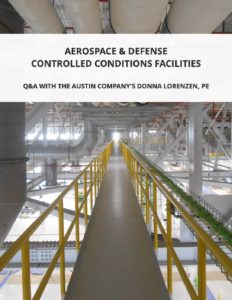Prior to the American Aerospace & Defense Summit 2018, we spoke with Donna Lorenzen, Chief Mechanical Engineer at The Austin Company to discuss controlled conditions facilities and best available technologies in the aerospace & defense industry. Donna’s experience in the design and engineering of facilities for the industry is considerable and current. With over 27 years of professional experience in the design and engineering of mechanical systems for aerospace and defense industry facilities, 24 years have been with The Austin Company.
This is an excerpt from the Q&A Generis Group did with Donna Lorenzen.
“With increased demand for composite materials and non-metallics in both commercial and military aviation, how has this impacted the facility environmental HVAC systems relating to controlling tight tolerances for temperature and relative humidity?
The main change has been that previously, manufacturing and assembly operations were performed in unconditioned spaces, often where they opened the doors to the ambient environment outside. Now, manufacturing and assembly operations are requiring much higher cleanliness and temperature and humidity control to the extent that, at times, if these conditions go out of spec – say the temperature is too high or too low, humidity is outside of the range or particulate counts are too high – engineers may have to shut down program manufacturing operations, whether it be manufacturing or testing, within that space, until the situation is remedied.
In some cases, that can even lead to discarding parts or assemblies because those critical environmental constraints were not met. Given this, the main change has been establishing a greater understanding of the temperature and humidity requirements, as they can vary greatly.
There are times where temperature or humidity must be maintained within a particular range. As engineers, we often create a box around the low and high temperature and the low and high humidity that are allowed, and design based on a central point. Another factor taken into consideration is weather conditions that are not apparent in the standard weather tables. If a facility has requirements to maintain the interior environment at all times (24/7/365), the engineer must take into consideration record temperatures, highs and lows, and other phenomena such as tropical weather that may occur in an ordinarily dry climate.”
Questions discussed:
- With increased demand for composite materials and non-metallics in both commercial and military aviation, how has this impacted the facility environmental HVAC systems relating to controlling tight tolerances for temperature and relative humidity?
- How are these systems adapted to maintain these critical environmental tolerances within large wide-span aircraft and spacecraft assembly centers or hangars with clear heights in access of 80′ or more?
- How is destratification achieved in such large envelopes, especially within harsh regional winter and summer temperature variations, such as the high desert conditions in Western U.S. vs. humid condition in the Southeast?
- With increased focus on energy efficiency, sustainability and lifecycle cost, how has the industry responded with the best available technologies?
- In manufacturing processes that involved fugitive emissions, particulates, NOx and VOC’s, how are current capture technologies responding to evolving EPA requirements?
Click through to access the full e-book here.

%20(1).png?width=773&height=112&name=Generis%20Logo%20full%20Colour%20(Large)%20(1).png)


-Nov-13-2025-01-18-02-9699-PM.png)
-2.png)